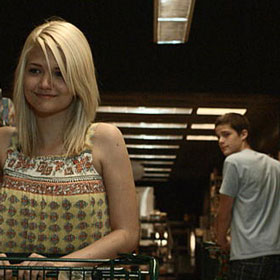The Myth of the American Sleepover

3/5
The Myth of the American Sleepover is a classic coming-of-age story about four teenagers trying to milk their last day of summer for all it’s worth. In comparison to many other films about teenagers trying to end their summer with a bang, this low budget indie film directed by David Robert Mitchell maintains innocence instead of taking it for granted. The cast is unknown, the film quality is antiquated to match the era and sexual contact doesn’t go past the point of kissing on the lips – there is not even a make out scene.
The individual adventures of these teenagers follow clichéd story lines and are filled with irrational, hasty and predictable behavior. Halfway through the film we can guess how the story will pan out, but the characters reach the true climax of their stories by exceeding our expectations. By the end of the film the four main characters have transitioned from childhood to adulthood facilitated by the various sleepovers and parties happening on the last night of summer in the suburbs of metro Detroit.
The film begins with the heavily pierced, cropped blond Maggie (Clair Sloma) and her nerdy best friend Beth (Annette DeNoyer). Maggie is surveying the pool boy and wishing she had done something more exciting with her summer before high school, specifically a guy. She jumps at her first chance, a boy named Cameron (Stephen Francis). He momentarily rejects her but sends her to a party instead, for which she ditches her sleepover party, where she obviously meets Mr. Pool Boy from earlier.
Though her voice is sweet and understandably alluring, Maggie self-consciously avoids eye contact one too many times to the point where it becomes irritating. We get it; you’re cute and nervous. There are moments when Maggie seems capable of breaking free from her insecurities, like when she spontaneously performs a dance routine in front of the party. She comes across as cool, but the coolness is unmerited because she never truly says what’s on her mind until she does.
Rob (Marlon Morton), an average looking kid, is also going to be a freshman in high school. We meet him in the supermarket as he crosses shopping carts with a blond bombshell. He searches for her throughout the film but misses her by an instant every time. Rob is superficial and obsessed with girls who are out of his league to the point that he lies about having sex with a girl to one of his friends. He is also so desperate for female attention that he inappropriately peeps on his friend’s sister in the bathtub at a sleepover party. Meanwhile his sister’s friend crushes on him the whole film, and he only learns to appreciate her when he realizes how slutty Blondie actually is.
Claudia (Amanda Bauer) a button-nosed redhead clad in pigtails is the new girl at school with a senior boyfriend. At track practice she meets Janelle Ramsey (Shayla Curran) who invites her to her slumber party that night. When Claudia’s boyfriend Sean picks her up, he and Janelle exchange an awkward “We have history” stare. Claudia inquires about it, and Sean begins to act shady. At the party, Claudia gets a bit too inebriated and starts snooping around Janelle’s room only to discover some information that will lead to her taking revenge.
Scott (Brett Jacobsen) sticks out as the oldest person in the film, but his maturity level is equivalent to that of a high school kid. When he picks up his sister at his old high school, he sees hanging in a memorabilia display case a photograph of himself talking to twin girls he used to be friendly with. Depressed about his recent break up with his girlfriend, he interrupts his sister at a sleepover party to find out where the twins are right now. She admits that they are at a freshman orientation sleepover at U of M, so naturally he gets in his car to track them down, completely aware of his craziness.
When Scott arrives at the school gym, which is occupied by rows of sleeping bags, he shamelessly walks through them until he “accidentally” steps on one that belongs to the twins. They are initially confused by his presence, but when he explains himself they become somewhat accepting of his desperation. The twins never fully indulge him the way he hopes, but their rationale provides him with some sort of clarity.
There are no long dialogues between characters or blatant explanations for people’s actions. These characters interact with a quiet understanding of angst that contradicts the negative perception of adolescence. The Myth of the American Sleepover depicts a fantasy world where there is little to no complexity in relationships. Despite its realistic feel, often times the events that occur are a bit too coincidental to be realistic, specifically the events involving Rob. At the same time, it is refreshing to see a film that doesn’t use technology as a facade to cover the characters’ fears or forge desired relationships.
RELATED ARTICLES
Get the most-revealing celebrity conversations with the uInterview podcast!





Leave a comment